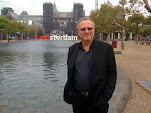
Near the ancient Mosque tower is
Djemaa el Fna, the Main Square and marketplace in old Marrakesh. It is filled with a bewildering array of food, spices, activities, hustles and street entertainment.
One of the photos (below) is from the morning scene when the square is practically empty. By this evening it was wall-to-wall people (see photo above).
From a distance it's like the scene from the lyrics of the "Marrakesh Express" song (by Graham Nash, Siquomb, 1969):
"... Colored cottons hang in the air,
charming cobras in the square, striped
djellebas we can wear at home."
But unfortunately close-up the
Djemaa el Fna can have a much harder edge. As with any, this marketplace has the potential to seek out the unsuspecting and turn seemingly benign practices distinctly ugly with a predatory feel. If you walk slowly and make eye contact you are likely to be approached ... and it all has a bit of a shakedown feel to it.
(Scott has the time-lapse photos of the tourist shakedown in action …look for it in his posts. And ... later he willingly participated in a spectacular way. So look for those photos, too)
Walking among the fortune-tellers, belly-dancers and seated men playing music to their cobras, my attention was captured by the costumed Berbers.
Berbers are the indigenous peoples of North Africa and the largest number of Berbers is found in Morocco. They speak both Arabic and French due to French colonization. Indeed, we met a few Berbers in Tangier. My favorite was
Momo, a tall, elegant man with an authoritative demeanor. He was our driver for a day as we toured the city. When asked about his name he explained that "momo" was the sound that cars make when they accelerate quickly from a complete stop.
So back in the square, a song-and-dance routine was performed for me by two colorfully dressed male Berber entertainers with tasseled hats. For a brief moment they played, sang and made the tassels on their hats rotate with circular motions of their heads. Then they turned on the charm with beautiful smiles and made their pitch for a few Dirham.
Next in my view were
Berber water-sellers dressed in elaborate traditional costumes and colorful hats with old-school leather water-bags and brass cups. The sun is really hot here even in late October but I was not tempted to purchase a drink.





































